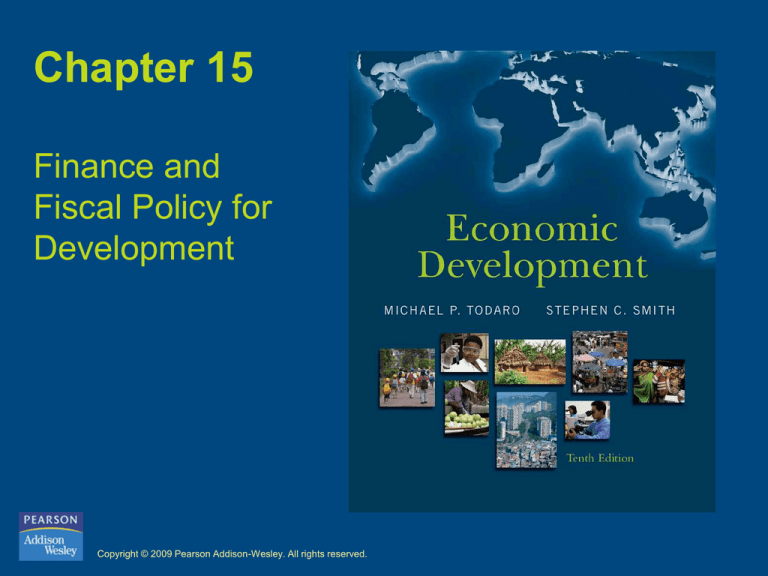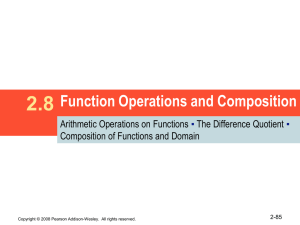
Chapter 15
Finance and
Fiscal Policy for
Development
Copyright © 2009 Pearson Addison-Wesley. All rights reserved.
The Role of the Financial
System
• Providing payment services
• Matching savers and investors
• Generating/distributing information
• Allocating credit efficiently
• Pricing, pooling, and trading risks
• Increasing asset liquidity
Copyright © 2009 Pearson Addison-Wesley. All rights reserved.
15-2
The Bumpy Road to
Macroeconomic Stability
• Macroeconomic stabilization has three
objectives:
– Getting inflation under control
– Restoring fiscal balance by reducing
governmental spending and by raising
government tax revenues
– Eliminating the current account deficit by means
of devaluation and export promotion
Copyright © 2009 Pearson Addison-Wesley. All rights reserved.
15-3
The Bumpy Road to
Macroeconomic Stability
• Differences between MDC and LDC
financial systems
– Monetary policy
– Money supply
– Who are the Keynesian economist?
– What is currency substitution?
– Currency substitution
Copyright © 2009 Pearson Addison-Wesley. All rights reserved.
15-4
The Bumpy Road to
Macroeconomic Stability
• Differences between MDC and LDC
financial systems (cont’d)
– Transparency
– Organized and unorganized money market
– Financial liberalization
Copyright © 2009 Pearson Addison-Wesley. All rights reserved.
15-5
The Bumpy Road to
Macroeconomic Stability
• The role of central banks:
– Issuer of currency and manager of foreign
reserves
– Banker to the government
– Banker to domestic commercial banks
– Regulator of domestic financial institutions
– Operator of monetary and credit policy
Copyright © 2009 Pearson Addison-Wesley. All rights reserved.
15-6
Table 15.1 Central Banking
Institutions
Copyright © 2009 Pearson Addison-Wesley. All rights reserved.
15-7
The Bumpy Road to
Macroeconomic Stability
• The role of development banking
– Development banks
• Informal finance
– Rotating savings and credit association
(ROSCAs)
Copyright © 2009 Pearson Addison-Wesley. All rights reserved.
15-8
Microfinance Institutions
• What is microfinance?
• Group lending schemes
Copyright © 2009 Pearson Addison-Wesley. All rights reserved.
15-9
Reforming Financial Systems
• Financial liberalization, real interest rates,
savings, and investment
– Rationing
– Financial repression
Copyright © 2009 Pearson Addison-Wesley. All rights reserved.
15-10
Figure 15.1 The Effects of InterestRate Ceilings on Credit Allocation
Copyright © 2009 Pearson Addison-Wesley. All rights reserved.
15-11
Reforming Financial Systems
• Financial policy and the role of the state
– Stiglitz’ seven market failures:
• The public good nature of monitoring financial
institutions
• Externalities of monitoring selection, and lending
• Externalities of financial disruption
• Missing and incomplete markets
Copyright © 2009 Pearson Addison-Wesley. All rights reserved.
15-12
Reforming Financial Systems
• Financial policy and the role of the state
– Stiglitz’ seven market failures (cont’d):
• Imperfect competition
• Inefficiency of competitive markets in the financial
sector
• Uninformed investors
• Debate on the role of stock markets
Copyright © 2009 Pearson Addison-Wesley. All rights reserved.
15-13
Fiscal Policy for Development
• Macrostability and resource mobilization
• Taxation: direct and indirect
– Five factors of the taxation potential of a country
Copyright © 2009 Pearson Addison-Wesley. All rights reserved.
15-14
Table 15.2 Comparative Average
Levels of Tax Revenue, 1985–1997, as
a Percentage of GDP
Copyright © 2009 Pearson Addison-Wesley. All rights reserved.
15-15
Table 15.3 Comparative Composition
of Tax Revenue, 1985–1997, as a
Percentage of GDP
Copyright © 2009 Pearson Addison-Wesley. All rights reserved.
15-16
Public Administration: The
Scarcest Resource
• Case of the Tazara railroad through
Tanzania and Zambia
Copyright © 2009 Pearson Addison-Wesley. All rights reserved.
15-17
State-Owned Enterprises
(SOEs)
• Improving the performance of SOEs
• Privatization: Theory and experience
Copyright © 2009 Pearson Addison-Wesley. All rights reserved.
15-18
Military Expenditures and
Economic Development
• What is military expending?
Copyright © 2009 Pearson Addison-Wesley. All rights reserved.
15-19
Table 15.4 Trends in Global Military
Spending, 1960–2000 (billions of U.S.
dollars)
Copyright © 2009 Pearson Addison-Wesley. All rights reserved.
15-20
Table 15.5 World Military Expenditures,
1994–2003 (billions of 2000 U.S.
dollars)
Copyright © 2009 Pearson Addison-Wesley. All rights reserved.
15-21
Table 15.6 Military and Social
Expenditures in Developing and
Industrial Countries, 1995
Copyright © 2009 Pearson Addison-Wesley. All rights reserved.
15-22
Table 15.7 Countries with the Highest
and Lowest Expenditures on the
Military, 2002 (% of GDP)
Copyright © 2009 Pearson Addison-Wesley. All rights reserved.
15-23
Table 15.7 Countries with the Highest
and Lowest Expenditures on the
Military, 2002 (% of GDP)
Copyright © 2009 Pearson Addison-Wesley. All rights reserved.
15-24
Case Study:
Chile
Copyright © 2009 Pearson Addison-Wesley. All rights reserved.
15-25
Case Study: Poland
Copyright © 2009 Pearson Addison-Wesley. All rights reserved.
15-26
Concepts for Review
• Central bank
• Group lending schemes
• Currency board
• Indirect taxes
• Currency substitution
• Informal finance
• Development banks
• Direct taxes
• Macroeconomic
stabilization
• Financial liberalization
• Microfinance
• Financial repression
• Monetary policy
• Money supply
Copyright © 2009 Pearson Addison-Wesley. All rights reserved.
15-27
Concepts for Review (cont’d)
• Organized money
markets
• State-owned
enterprises (SOEs)
• Privatization
• Transparency
• Rationing
• Unorganized money
markets
• Rotating savings and
credit associations
(ROSCA)
Copyright © 2009 Pearson Addison-Wesley. All rights reserved.
15-28








